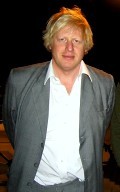
UPDATE: June, 2010
I recently learned of the FNAL “Drawings of scientists” project, which shows “Before and After” pictures of scientists after school students visited Fermilab. The image below is probably one of the most telling, but there are many others in a similar vein. Perhaps the solution to the problem is simply to arrange for all school students to have the opportunity to visit a real laboratory with real scientists of various flavours.

The wacky characters that introduce kids to science may be doing more harm than good. Reinforcing the white-man-in-a-lab-coat or mad-scientist stereotype could diminish not only children’s interest in science, but also the diversity of future scientific workplaces.
The Web is littered with “Ask a Scientist” sites aimed at getting children “into” science. Some of these sites do provide useful resources for youngsters curious about things such as “Why is the sky blue?”, “Why do men have nipples?“, and “How can I best extrapolate a Hurter-Driffield curve in my experiments on photographic material transmission densities?”
OK, I made that last one up. But the critical feature of many of these sites is the personification of the so-called expert with names like Ask a Boffin, “Find Out Why with Dr. Calculus,” Ask a Mad Scientist, or some such. Almost invariably, a cartoon character will be a stumpy guy in a white coat, with wild gray hair, waving a test tube around or wielding a clipboard. And, on the whole, he will be white. I was personally involved in one such “expert questions” site several years ago, and to my chagrin, the editor called the site “Ask the Egghead” – and created just such a character in the form of Professor Hypothesis.
What does this say about the common adult perception of how children perceive scientists? Well, for a start, it reinforces the classic stereotype of scientists as absent-minded professor cliche, generally messing around with chemicals or constantly scribbling notes in lab books and, almost certainly, white and male.
While grandiose efforts to promote high-quality science education abound, and public understanding of science (PUS) initiatives are high on the agendas of learned societies everywhere, these could be doomed from the outset by ingrained views we gain as children about what scientists do, what they look like, and who they are.
A fairly formal assay of children’s views of scientists was undertaken recently by a team at Leicester University in England and Australia’s Curtin University of Technology. Although the results have not yet been published, based on preliminary analysis the main conclusion from the research is that children think of scientists as boring white men with glasses, beards, and strange hair. According to lead researcher Tina Jarvis, director of Leicester’s School of Education, many children say they do not want to be a scientist because scientists never have fun!
Jarvis and colleagues, along with Lionie Rennie of Curtin, studied the responses of more than 4,000 children in Britain and Australia over the last eight years and concluded that the stereotypes persist, at least among six- to eight-year-olds. Worryingly, children of Asian and African-Caribbean descent generally held the same opinion as their white peers. Most children’s sketches of scientists endowed them with a white, male face and the usual eccentric hair. Boys, Jarvis says, never drew women, and girls did so only very occasionally. While there may well be a minority of scientists who fit the category, it indicates a very narrow view of scientists, one that is so very often reinforced through TV programs and cartoons, comic books, and comments from nonscientist parents and other adults. We then wonder why so many girls and non-white children find it very difficult to envision themselves as future scientists.
Elizabeth Moss, a Cambridge, England mother of two young children, believes there is a simple explanation for these results: “From age 2 or 3 to 5, children have such vivid imaginations, but then they go to school and are made to feel that they should think and act like everyone else and they seem to lose their individual imaginations, and draw what is expected of them.”
Alan Gray is 13 and in eighth grade in Ontario, Canada. “Recently, in our science class, we were asked to draw a picture of a scientist,” he reports. “When we handed it in, our teacher got what she expected: mostly all of us had drawn men with white lab coats and tubes with liquids in them.” He does not think the class was pandering to a greater stereotype, though. “If you asked us to draw popular kids, we’d draw them with makeup and nice clothes and big houses. If you asked us to draw farmers, we’d draw men with overalls, baseball caps, and straw in their mouths.”
Marilyn Fleer, associate professor of education at the University of Canberra in Australia, notes, “Although there are still stereotypical responses given when children are asked to draw a scientist, if you interview them they will qualify their work by saying they had to draw it that way, so that you know what it is.”
“This is an interesting area,” says Christine Khwaja, who teaches primary school teachers at Middlesex University in London. But she also asks whether children draw scientists as boffins because that is what they think scientists are really like, or because that is what they think they are expected to draw? “There seems to be very little in the national curriculum on the nature of science, who does it, and why,” she adds. She suggests, “A discussion around these areas might make children think more widely about who is a scientist and what scientists actually do.” She even suggests that there are many jobs, from hairdresser to zookeeper, in which science is important and that children’s image of scientists might be helped by raising awareness of these.
West Coast scientist and teacher Monique DeRuggiero says she much prefers jeans to lab coats, although she still keeps a well-decorated lab coat for messy labs and is not concerned by revelations of children perceiving scientists as stereotypes. “I do not see a problem with children drawing pictures of scientists as men in white coats; we do need to know what children’s perceptions are before we can change them.” She emphasizes the point that once you know what children expect, you can then teach them the reality by exposing them to examples of real scientists, showing them pictures, movies, stories of all types of scientists in all types of work. Getting real scientists to visit the school or taking a class trip to a lab can also help eradicate misconceptions.
Jupadhye Upadhye, a computer programmer with an Indian software company based in Singapore, blames comic books with characters like Inspector Gadget and stories that are littered with scientist stereotypes: Professor Calculus, Captain Nemo, Frankenstein, “Doc” Brown in the movie Back to the Future – even legendary quirky scientists such as Newton, and especially Einstein. “All of these add to the image,” she says. “Moreover, everyone likes to build myths and interesting characteristics around scientific personalities, to set them aside as somehow different from the rest of us.”
“It is important to challenge children in their thinking, and the adults who work with them,” believes Kate Banfield, who manages a preschool daycare center in West Yorkshire. If the children are portraying scientists as white middle-aged men in lab coats, she says, you need to offer them an alternative experience. Invite non-white or female scientists from local labs to talk about their work; find books and stories about scientists who are women or ethnic minorities. However, the most important strategy for breaking down stereotypes is to raise children’s awareness of what they are and how they are perpetuated. Encourage them to question assumptions and confront stereotypes.
The SCICentre (National Centre for Initial Teacher Training in Primary School Science) at Leicester University, of which Jarvis is director, produces materials to educate parents and educators about science, scientists, and technology. The latest booklet, entitled Helping Primary Children Understand Science and Technology, seeks to improve children’s ideas of scientists by getting them involved in activities such as role playing, discussions, and reading and writing about science. The booklet is illustrated with photographs of a diverse range of scientists at work with the aim of broadening views, presumably of both children and educators.
But Martin Counihan of the University of Southampton worries that children don’t think very much about scientists at all these days, compared with a couple of decades ago. “What image do children have of other rare breeds such as, say, theologians? Or historians?” he asks. “And insofar as children do think about scientists, their image is probably colored much more by the biosciences than previously.”
With the focus in school curricula on numeracy and literacy, especially in the U.K., there is little room for science. Yet Jarvis believes there is no reason why science cannot be incorporated into these two key areas and indeed enhance them. She believes that if children do not learn to love science before they are eleven, then the scientific part of their secondary education is essentially lost on them.
Fleer has looked into how technology education for young children has changed through the years. There’s been an increase in resource development to support technology teaching in schools, she says, but only a limited amount of research has been done in the three-to-eight-year-old age group to assess the effects. Although most parents are familiar with the seemingly innate scientific curiosity of their offspring, Fleer’s pilot study revealed that children as young as three years can engage in oral and visual planning as part of the process of making things, such as model giraffes and butterflies, from different materials.
Greg Degeyter is a meteorologist from Mississippi State University who has made several school appearances. “The students seemed genuinely interested in what was being said. Any well-presented information seems to strike their imagination and make them interested in the subject,” he says. He does not feel that the children expected someone in a white lab coat, but then accedes that most of their experiences with a meteorologist includes someone in a dress coat and tie, and suggests that is what they expect. “In general,” he adds, “I do think that children are intimidated by science. Perhaps not the younger ones but as they get older.” As for stereotypes seen by younger children, “It probably is true for scientists in general,” he suggests, “Most children seem to think of a doctor as someone who studies science, and he is in white garb.” He asks whether it is a bad thing. “Children think of scientists as smart, albeit a bit weird (as shown by the hair), and dedicated to the profession. If anything should be done it is to have more interaction between the scientific community and the public.”
Toby Bankson, a ninth grader in Mountlake Terrace, Washington, believes the stereotype may actually have some benefits. “It may be one of the things that turns a young child’s eyes toward science in the first place,” she says. “In a video show at school, for instance, would kids watch a ‘normal’ scientist for even 15 minutes?” she asks. Which is why shows like Bill Nye: The Science Guy and Beakman’s World are so popular and get children to pay attention willingly to information about science. “With everything else a kid could watch these days, that’s a small miracle!” adds Bankson.
Stereotypes persist in all walks of life, but in the realm of science, where public trust has become frazzled by the seeming autocracy of those guys with crazy hair wearing lab coats and wielding chemicals, perhaps it’s time to say goodbye to Professor Hypothesis and his cronies, and introduce children to some real scientists.
This feature article originally appeared under the title, Uncool boffins, all – children’s stereotypes of scientists – in my Adapt or Die column in the sunk HMSBeagle on the scuppered BioMedNet, it was reprinted here 2001-05-21 but hopefully its sentiments are worthy of repeating today if only to nudge the Null Physics item down to #2 ;-)
 A discussion a while back, over a few beers, with a Buddhist friend about life, the universe, and everything (what else?) got around to the subject of null physics and the notion that the universe may always have existed and may exist for eternity to come.
A discussion a while back, over a few beers, with a Buddhist friend about life, the universe, and everything (what else?) got around to the subject of null physics and the notion that the universe may always have existed and may exist for eternity to come. First up in The Alchemist this week is a tale of reactions where size really does matter! News of why “non-smokers cough” emerges from the American Chemical Society meeting this month and a new physical process has been revealed by NMR spectroscopy of frozen xenon atoms that could provide a chaotic link in quantum mechanics back to Newton’s era. Biotech news hints at a novel way to flavour your food and Japanese chemists have made a gel that undulates like intestinal muscle. Finally, this week’s award goes to my good friend AP de Silva of Queen’s University Belfast for his highly intelligent work in the development of market-leading sensor technology and intelligent molecules.
First up in The Alchemist this week is a tale of reactions where size really does matter! News of why “non-smokers cough” emerges from the American Chemical Society meeting this month and a new physical process has been revealed by NMR spectroscopy of frozen xenon atoms that could provide a chaotic link in quantum mechanics back to Newton’s era. Biotech news hints at a novel way to flavour your food and Japanese chemists have made a gel that undulates like intestinal muscle. Finally, this week’s award goes to my good friend AP de Silva of Queen’s University Belfast for his highly intelligent work in the development of market-leading sensor technology and intelligent molecules. For Scousers, Londoners, fans of BBC’s Have I Got News for You satirical news quiz, and especially to everyone who watched this Beijing to London Olympic handover this week the name Boris Johnson likely drums up an image of some blonde, floppy haired, bedraggled and totally confused Tory toff, who just happens to be Mayor of London.
For Scousers, Londoners, fans of BBC’s Have I Got News for You satirical news quiz, and especially to everyone who watched this Beijing to London Olympic handover this week the name Boris Johnson likely drums up an image of some blonde, floppy haired, bedraggled and totally confused Tory toff, who just happens to be Mayor of London.


 Apparently, scientific thought needs rekindling, seemingly it has run out of kindle and needs a new flame if it is to burn brighter. In steps Terence Witt with the concept of null physics. Witt has now self-published a hefty tome by the name of Our Undiscovered Universe.
Apparently, scientific thought needs rekindling, seemingly it has run out of kindle and needs a new flame if it is to burn brighter. In steps Terence Witt with the concept of null physics. Witt has now self-published a hefty tome by the name of Our Undiscovered Universe. In my ChemWeb column, The Alchemist, this week:
In my ChemWeb column, The Alchemist, this week: Here is a sneak preview of the various science news items I have scheduled to appear on August 15 over on SpectroscopyNOW.com
Here is a sneak preview of the various science news items I have scheduled to appear on August 15 over on SpectroscopyNOW.com